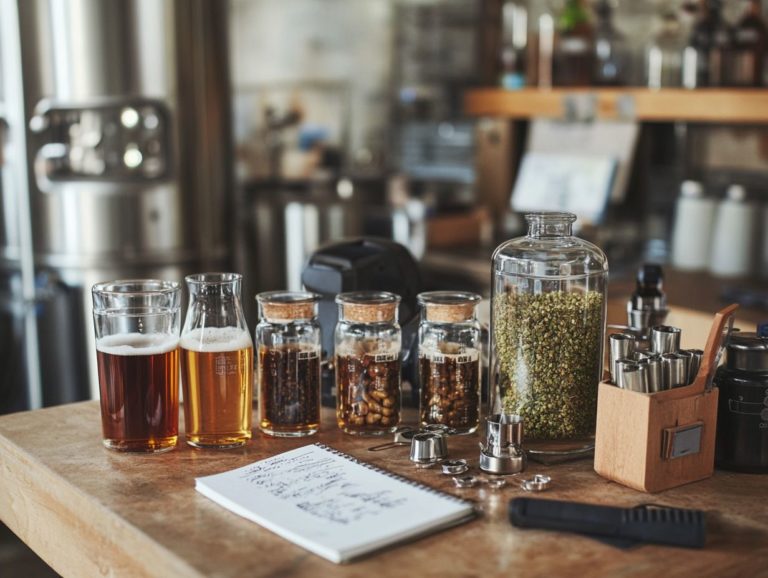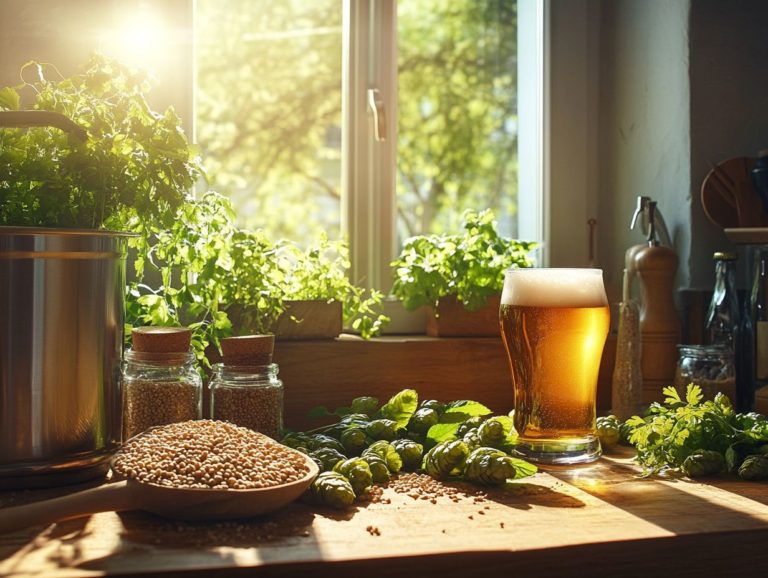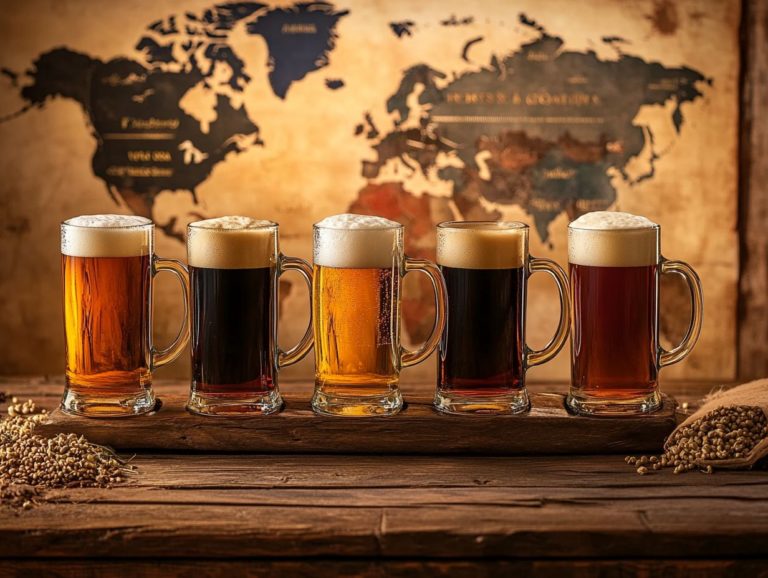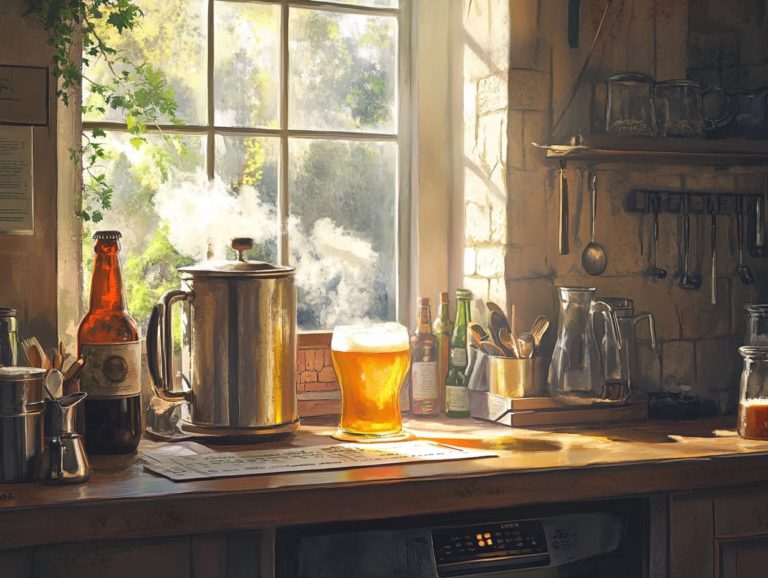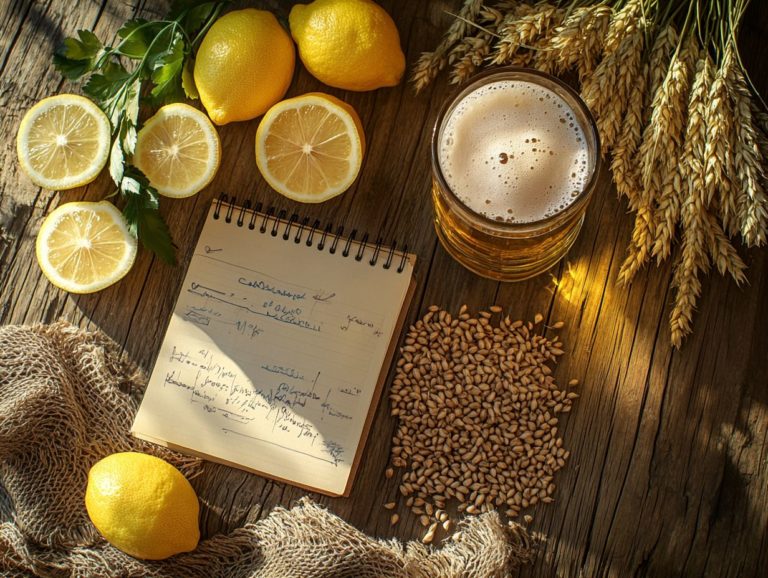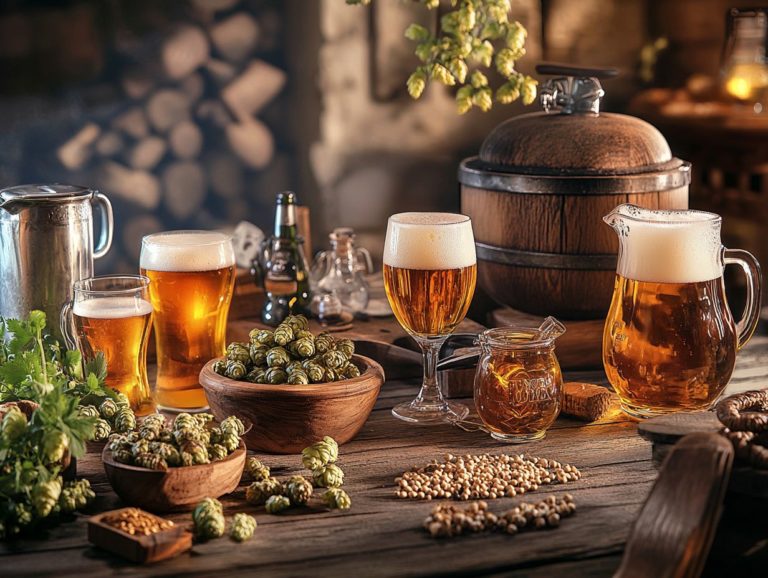How to Make Beer Recipes with Flavorful Additives
Beer enthusiasts and aspiring homebrewers will uncover a wealth of knowledge in this comprehensive guide to crafting your own brews and developing exceptional homebrew recipes. You will also find a detailed step-by-step process for brewing beer at home, from initial brewing water selection to fermentation temperature control, along with innovative methods to elevate your recipes with delightful additions such as fruits, spices, and herbs.
Delve into the rich and varied world of beer styles, from refreshing ales to robust stouts, and gain a clear understanding of the essential ingredients required for brewing: water, malt, hops, and yeast. Understanding these key ingredients is vital for mastering various brewing techniques and creating balanced beer recipes.
Unleash your inner brewmaster and embark on a flavorful journey today, discovering the art of beer brewing and recipe development!
Contents
- Key Takeaways:
- Types of Beer
- 3. Stout
- Basic Ingredients for Making Beer
- How to Make Beer at Home
- 2. Sanitize Equipment
- 3. Prepare the Wort
- 4. Add Flavorful Additives
- Flavorful Additives for Beer Recipes
- 1. Fruits
- 2. Spices
- 3. Herbs
- Frequently Asked Questions
- What are some flavorful additives that can be used in beer recipes, according to BJCP style guidelines?
- How can I incorporate fruit into my homebrew recipes?
- What spices work well in homebrew recipes?
- Can I add coffee or chocolate to my homebrew recipes?
- Are there any unique ingredients I can use in my beer brewing?
- How do I know if I’ve added too much of a flavorful additive to my beer design?
Key Takeaways:
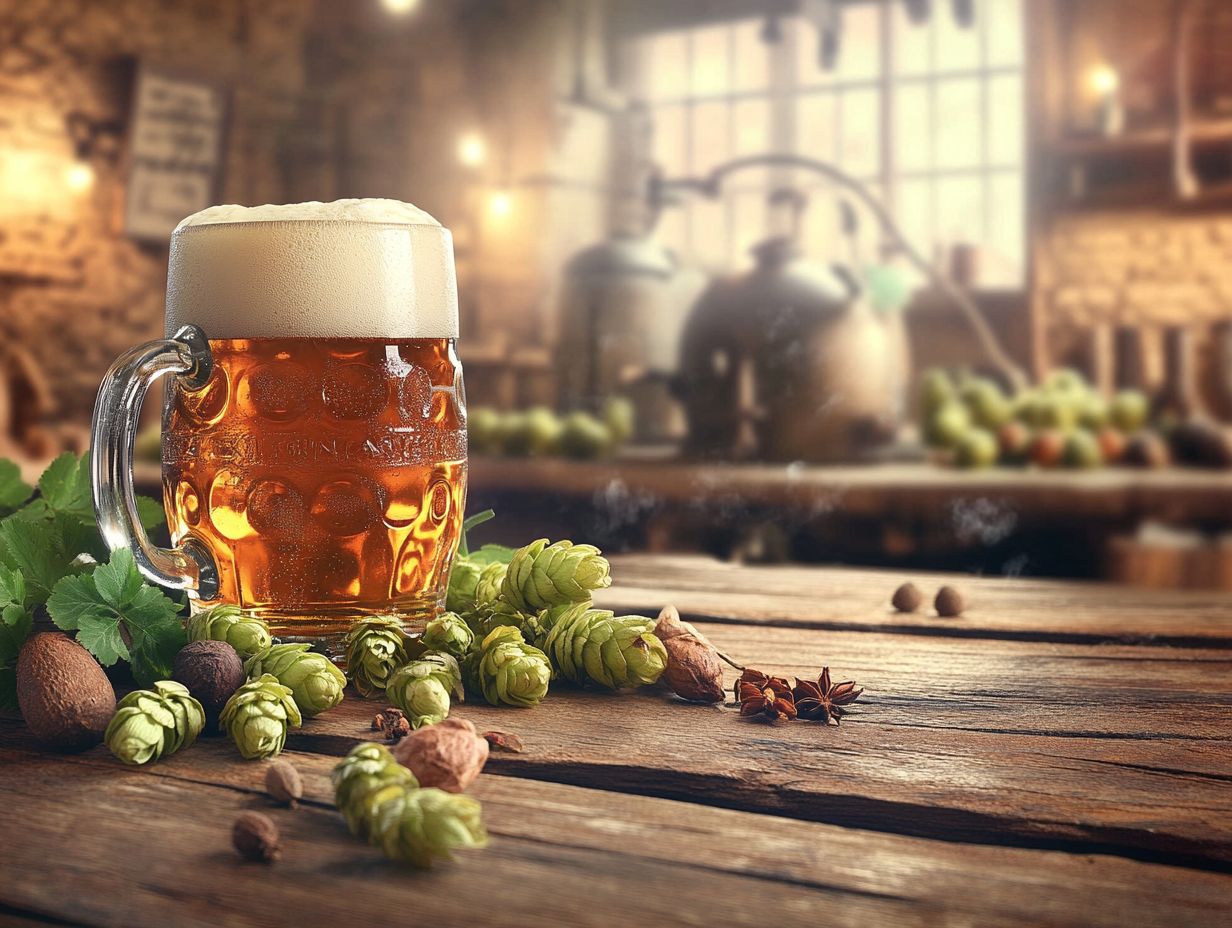
- Experiment with different types of beer (ale, lager, stout) to find your favorite flavor profile, and refer to Beer Judge Certification Program (BJCP) style guidelines for additional inspiration.
- Water, malt, hops, and yeast are the essential ingredients for making beer at home.
- Get creative with flavorful additives like fruits, spices, herbs, and other flavorings to enhance your beer recipes, integrating specialty malts and various hop varieties.
Types of Beer
Understanding the various types of beer is essential for you as a homebrewer striving to master the art of brewing. With a wide array of beer styles, including ales, lagers, and stouts, each type presents unique characteristics that showcase different brewing techniques and ingredients. You can explore online recipe databases and brewing books for more information on each style.
From the fruity esters found in ales to the crisp cleanliness of lagers, each style offers diverse flavor profiles that cater to your distinct palate. You have the opportunity to experiment with these styles, learning how to balance key ingredients to craft your desired brew, ultimately enhancing your brewing skills and deepening your appreciation for this beloved beverage. Joining a brewing community or entering homebrew competitions can also provide valuable feedback on your creations.
1. Ale
Ales represent a diverse category of beer, celebrated for their intricate flavors and enchanting aromas. Typically crafted with top-fermenting yeast strains at warmer fermentation temperatures, this method allows for the emergence of fruity and estery notes that beautifully complement the rich malt flavors inherent in the brew.
As you explore different ale styles be it pale ales, IPAs, or stouts you’ll encounter unique hop varieties that impart distinct bitterness and aromatic qualities. For example, an IPA might tantalize your palate with citrusy and piney hop profiles, while a stout unfolds its story through rich, roasted malt characteristics.
The fermentation processes involved in creating these ales play a crucial role in shaping the final flavor. Variations in temperature can lead to the production of a delightful array of esters (compounds that contribute fruity flavors) and phenols (which add spicy or smoky notes). By diving into these techniques, you can truly appreciate the rich tapestry of tastes that ales have to offer. Consider utilizing brewing software to track your fermentation process and ensure consistency.
2. Lager
Lagers are a beloved category of beer, brewed with bottom-fermenting yeast that yields a clean and crisp taste, often accompanied by a well-balanced flavor profile.
These beers span a variety of styles, including Pilsners, Helles, and M rzen, each one marked by its distinct brewing techniques and fermentation processes. You ll find that lagers typically ferment at lower temperatures, allowing the yeast to work at a leisurely pace, resulting in a smoother, more refined taste. Refer to Beer Judge Certification Program (BJCP) guidelines for specific style requirements.
Water chemistry is crucial in the brewing process, as the mineral content can affect everything from sweetness to bitterness in the final product. For you as a brewer, grasping the delicate balance between malts and hops is vital; achieving this harmony is essential for highlighting the beer’s inherent flavors and aromas. Tools like EZWaterCalculator can help you fine-tune your brewing water for optimal results.
In conclusion, homebrewing offers an exciting opportunity to explore your creativity and enhance your understanding of beer. With practice and experimentation, you can develop your unique recipes and share them with friends and family.
3. Stout
Stouts are rich, dark beers renowned for their complex flavors, often arising from roasted barley and specialty malts. This combination contributes to their signature malt sweetness. Sometimes, this sweetness is accompanied by an intense bitterness.
You can explore several distinct styles of stouts, such as Irish dry stouts, oatmeal stouts, and imperial stouts. Each style highlights unique brewing techniques and flavor profiles. The variety of malts used is crucial in defining the overall taste. For instance, chocolate malt can impart delightful cocoa notes, while crystal malts may introduce a touch of caramel sweetness.
Brewers often experiment with recipes, adjusting mash temperatures and hop additions. These modifications can significantly alter the beer’s body and mouthfeel. This practice ensures that every stout possesses a distinct personality crafted to satisfy your refined palate. Collaborating with other brewers and entering homebrew competitions can provide you with new insights and inspiration for your recipes.
Basic Ingredients for Making Beer
Crafting the perfect beer recipe starts with a deep understanding of the essential ingredients required for brewing: water, malt, hops, and yeast. These fundamental ingredients are the building blocks of every successful brew.
Each component shapes the overall flavor, aroma, and quality of your final brew. Water chemistry is particularly important; the mineral content can significantly affect the beer’s characteristics. Malt brings the necessary sugars and flavors to the table, while hops provide essential bitterness and an aromatic profile. Understanding the bitterness ratio and the alpha acids in your hops can help you fine-tune your beer’s bitterness level.
Finally, yeast is the magic worker that ferments the sugars, producing alcohol and adding layers of flavor complexity. These key ingredients are fundamental to developing a successful beer recipe that will impress.
1. Water
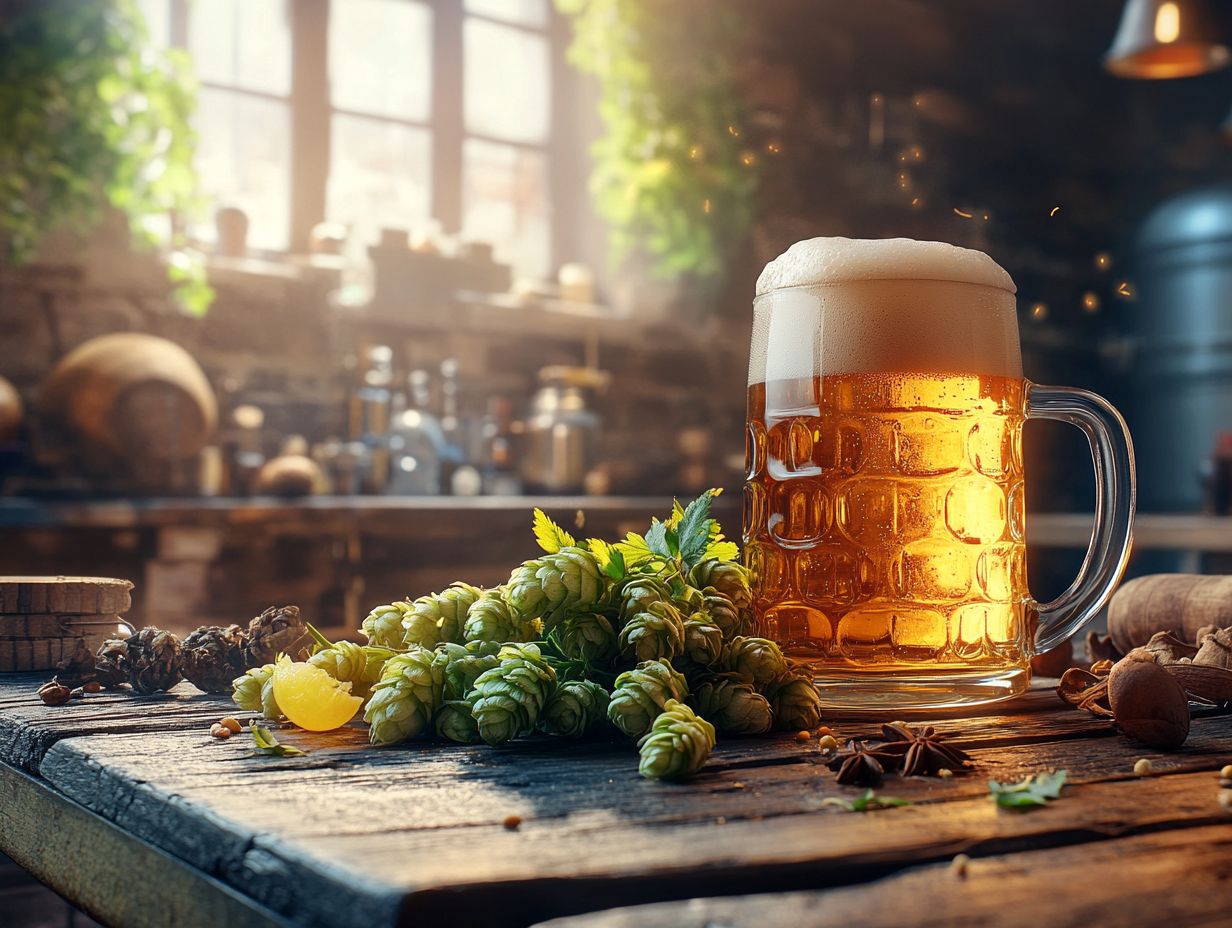
Water is often an overlooked ingredient in brewing, yet its chemistry plays a crucial role in crafting a balanced beer that aligns with your expectations as a brewer.
The type of water you use whether it’s soft, hard, or mineral-rich can dramatically influence both the brewing process and the flavor profile of your final product. For instance, soft water, with its low mineral content, is perfect for brewing delicate styles like pilsners that demand a crisp taste. Conversely, hard water, which boasts higher levels of calcium and magnesium, offers a fuller mouthfeel and enhances flavor extraction from the malt. Proper malt extraction and water chemistry adjustments are key elements in achieving your target beer style.
Specific minerals can also significantly impact the flavor; sulfate can amplify hop bitterness, while chloride can enrich a malt-forward flavor. By grasping the nuances of water chemistry, you can fine-tune your brewing process and create beers that truly reflect your stylistic aspirations.
2. Malt
Malt is the backbone of beer, providing the fermentable sugars essential for alcohol production while also contributing to the beer’s color, flavor, and body. The grain bill often consists of a mix of base malts and specialty malts tailored to create desired malt flavors.
As you explore brewing, you’ll find a variety of malts categorized into two main types: base malts and specialty malts. Base malts, like Pilsner or Pale, typically dominate the grain bill, offering a neutral flavor profile while delivering crucial sugars for fermentation.
In contrast, specialty malts take a backseat in quantity but play a vital role in crafting distinct flavors and colors. Options such as caramel, chocolate, and roasted malts can add delightful notes ranging from toffee and nuts to rich coffee and chocolate, creating a complex tapestry of flavors.
During the mashing process, the starches from these malts undergo the process where starches turn into sugars, facilitating significant extraction that influences the beer s final characteristics. This thoughtful combination shapes the overall experience of your brew, ensuring that each recipe reflects your intended style and taste.
3. Hops
Hops are an essential component in brewing, recognized for their ability to impart bitterness, flavor, and aroma to beer while also acting as a natural preservative. Effective hop utilization is a critical skill for any brewer aiming to achieve balanced flavors and a pleasing hop aroma.
Each hop variety presents unique characteristics that can profoundly impact the beer’s overall profile. For instance, varieties like Citra and Mosaic unleash vibrant citrus and tropical fruit notes. Others, such as Saaz and Tettnanger, contribute herbal and earthy qualities. Understanding hop utilization rates and alpha acids is essential for achieving your desired bitterness level.
Hops can be introduced at different stages of the brewing process. Earlier additions during the boil significantly enhance the beer’s bitterness, whereas late hop additions, or dry hopping, elevate aromatic qualities with minimal bitterness. This strategic layering not only balances flavors but also enables you to create distinct experiences with each batch, highlighting the incredible versatility of hops.
Proper hop additions and timing are crucial for achieving optimal flavor balance and hop aroma in your brews.
4. Yeast
Yeast serves as the ingredient that converts sugars into alcohol during fermentation. Your choice of yeast strain can dramatically influence the flavor and aroma profile of your beer.
With a vast array of yeast strains at your disposal, each comes with its own unique fermentation temperature requirements that can significantly shape the character of your final brew. For example, lager yeasts thrive in cooler temperatures, yielding a clean and crisp taste. In contrast, ale yeasts flourish in warmer conditions, producing fruity and complex flavors. Understanding these specific needs is essential for you as a brewer aiming to craft a particular style.
Utilizing brewing software simplifies yeast management and fermentation tracking, giving you precise control over temperature and timing. Paying close attention to these details can transform your beer into something extraordinary! Tools like BeerSmith and BeerSmithRecipes.com can aid in managing your yeast strains and ensuring proper fermentation.
How to Make Beer at Home
Embark on your brewing journey with guidance from the Homebrewers Association and other reputable sources. From initial recipe development to the final stages of fermentation, this section covers all aspects of homebrewing to help you craft the perfect brew. Explore brewing equipment options and online recipes to refine your brewing methods and achieve your target beer style.
Crafting beer at home is an exhilarating journey that enables you to unleash your creativity and hone your brewing skills through immersive, hands-on experience. It all starts with meticulous planning for brew day, where you’ll gather the essential brewing equipment and adhere to a structured brewing process tailored to your chosen homebrew recipe.
As a homebrewer, you’ll have the freedom to experiment with various ingredients and brewing techniques, allowing you to dive into a vibrant brewing community of fellow enthusiasts. The shared knowledge and passion for creating exceptional beers are both cherished and celebrated.
1. Gather Supplies
The first step in brewing beer at home is to gather all the essential supplies and brewing equipment, ensuring that you’re fully prepared for an enjoyable brew day.
- Large kettle for boiling
- Fermentation buckets
- Airlock
- Hydrometer
- Malted grains
- Hop varieties
- Yeast strains
- Water
Taking the time to prepare properly before diving into the brewing process not only streamlines your workflow but also helps you avoid potential hiccups. This ensures that your homemade beer turns out both flavorful and delightful.
By thoughtfully selecting each component, whether you re a novice or a seasoned brewer, you can craft a uniquely satisfying ale that reflects your personal taste and brewing techniques.
Gather your supplies now to ensure a smooth brewing experience!
In summary, the steps involved in homebrewing include planning your recipe, gathering your supplies, and meticulously following the brewing process to create your unique beer.
2. Sanitize Equipment
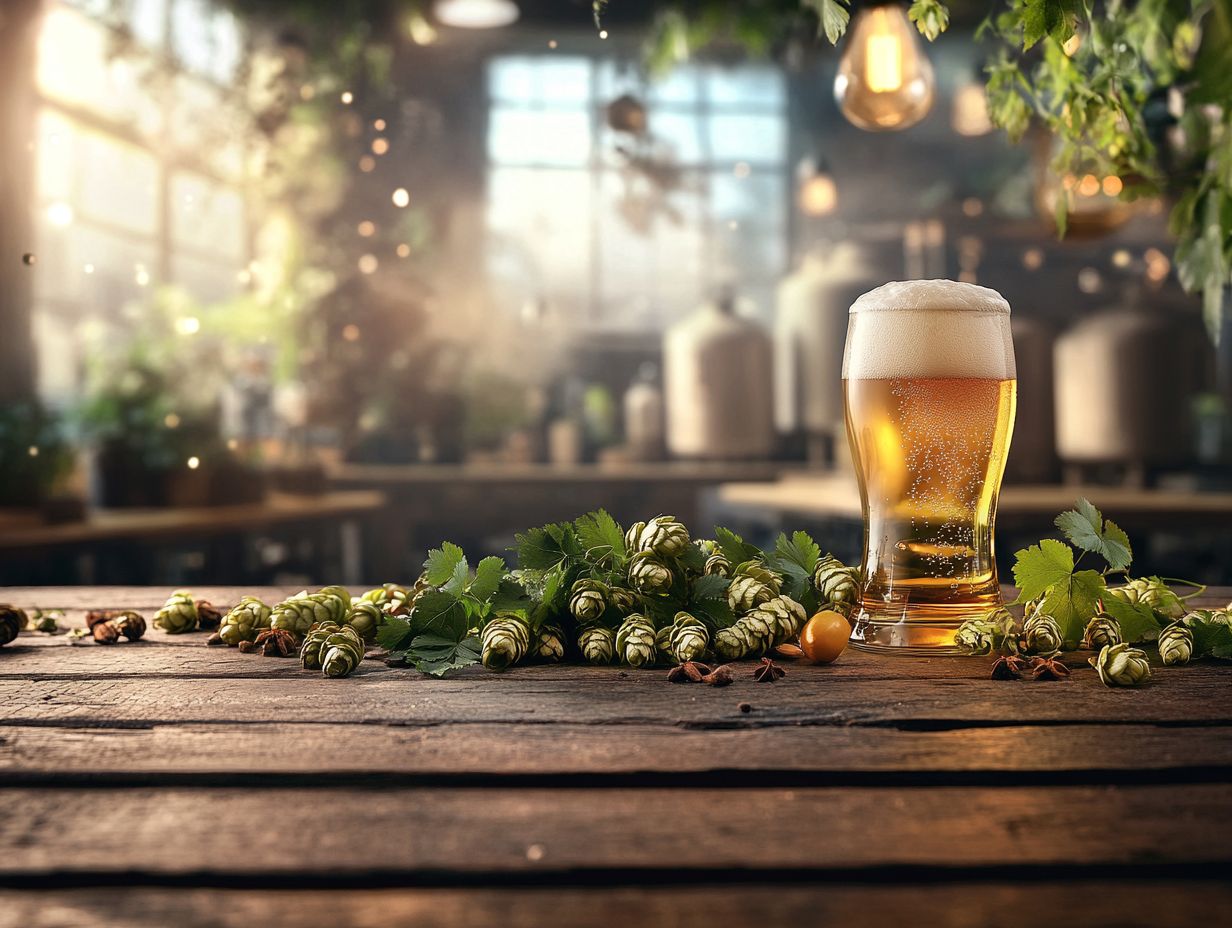
Sanitizing your brewing equipment is an essential step in the brewing process. It helps prevent contamination and ensures a clean fermentation environment conducive to balanced flavors.
By utilizing a variety of sanitization methods and products, you protect the integrity of your homebrew and enhance your chances of success during homebrew competitions. You can choose from chemical sanitizers like chlorine and iodophor or opt for effective heat-based methods, such as boiling or steam cleaning.
Each option offers unique advantages, allowing you to select processes that align with your specific brewing needs. Consistently employing proper sanitization techniques promotes quality and excellence in every batch, ensuring that each sip reflects the dedication and craftsmanship you pour into your brewing experience.
3. Prepare the Wort
Preparing the wort is an essential phase in your brewing journey. It involves extracting sugars from the malt and getting the right sugar level for your beer, as calculated by brewing software.
This process begins with mashing, where you mix crushed grains with hot water to activate enzymes that convert starches into fermentable sugars. This is a key aspect of malt extraction.
The temperature and duration of your mash are crucial, significantly influencing the body and sweetness of your final brew. Once mashing is complete, you ll separate the wort from the spent grains and move on to boiling.
This step is critical, as it sterilizes the liquid and allows you to introduce hops. These hop additions provide bitterness, aroma, and flavor that beautifully balance the sweetness from the malt.
All these stages intricately shape your beer s flavor profile, clarity, and stability. This culminates in a delectable finished product that pays homage to the rich traditions of craft brewing as championed by the homebrewers association.
4. Add Flavorful Additives
Incorporating flavorful additives during the brewing process can elevate your beer recipe. These ingredients introduce distinctive flavor profiles and invite a world of creative experimentation.
Consider using ingredients like fruits, spices, and herbs, as often detailed in beer brewing books. For more ideas, explore creative additives for brewing. Carefully selecting and integrating these additives allows you to achieve an impressive balance of flavors that enhances the base beer style.
For example, adding citrus peels or tropical fruits can infuse your brew with a vibrant aroma and refreshing finish, especially in hop-forward beers like IPAs. Conversely, spices such as coriander or cinnamon can introduce warmth and complexity to darker ales or stouts.
Such techniques are employed by renowned breweries like BrewDog and Trillium. By incorporating these elements at various stages of brewing during the boil, fermentation, or even as dry additives you can take a nuanced approach to flavor development.
Transform a standard brew into an unforgettable experience, much like the celebrated beers from Brooklyn Brewery and Hill Farmstead. Don t miss the chance to transform your brewing game with exciting flavors! Experiment today!
Flavorful Additives for Beer Recipes
Flavorful additives are essential for crafting unique beer recipes that delight the palate and enhance the overall drinking experience. Whether you incorporate fresh fruits, aromatic spices, or fragrant herbs, these ingredients can profoundly influence your homebrew’s flavor profiles.
By experimenting with diverse combinations, you achieve an exquisite balance of flavors, ultimately customizing your creations to align with your personal tastes and preferences, as exemplified by brewers like WeldWerks and Outer Range.
1. Fruits
Incorporating fruits into your beer recipes can transform your brews with refreshing flavors and enticing aromas, making it an exhilarating choice for homebrewers eager to explore unique flavor profiles.
Imagine adding fruits like raspberries, peaches, and oranges. They elevate your beer with vibrant notes that enhance the drinking experience. Raspberries, for example, offer a delightful tangy sweetness that perfectly complements wheat beers. Peaches contribute a luscious, juicy character to pale ales. Don t overlook the magic of citrus peels, which enhance aroma while delivering a zesty punch to invigorate your brew. Such innovations are often seen in grapefruit double IPAs crafted by top breweries.
For the best results, consider adding fruits during the second stage of fermentation. This method allows the yeast to interact with the fruit sugars without overpowering the brew. And remember, proper sanitation is crucial to prevent any off-flavors, ensuring that the fruity essence shines through in every sip.
2. Spices
Spices represent an intriguing category of flavorful additives capable of dramatically transforming the taste and aroma of beer, adding complex layers that elevate your overall drinking experience. Mastering the use of these ingredients is often discussed in beer judge certification programs and brewing books.
Incorporating spices into your brewing process can be a game-changer for both homebrewers and craft beer enthusiasts. These aromatic ingredients introduce unique flavors and offer health benefits. For example, adding spices like coriander can lend a refreshing citrus note, while a touch of cinnamon brings a warm, sweet spiciness.
The secret to achieving flavor balance lies in your ability to determine when and how much of each spice to use, ensuring these powerful additives complement rather than overshadow the base ingredients. As you craft your beer recipes, don’t hesitate to experiment with different combinations. You may discover truly remarkable results that create a harmonious blend, captivating the palate and encouraging repeat tastings. For more insights, check out tips for using additives to harness the power of brewing software and online recipes to achieve that perfect brew today!
3. Herbs
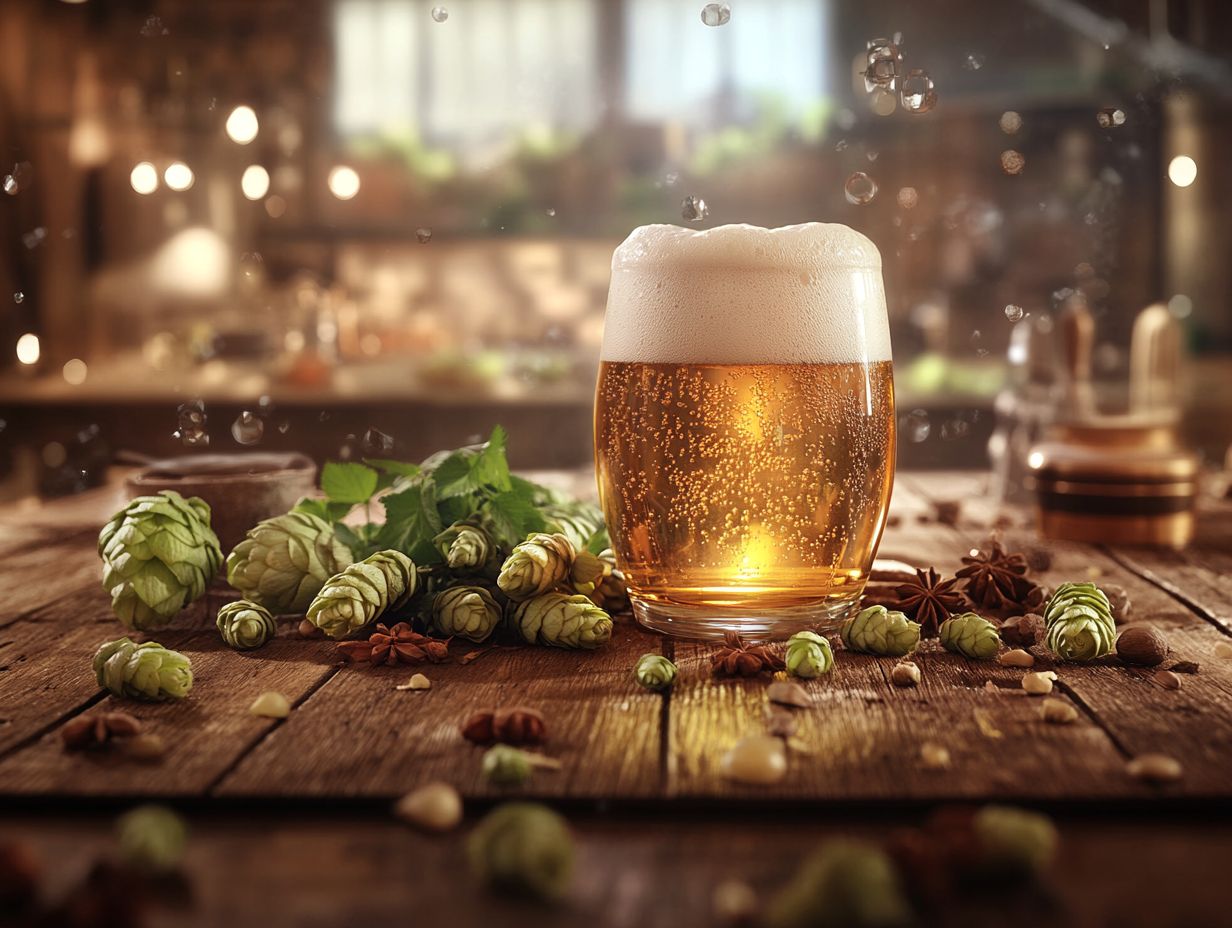
Incorporating herbs into your beer brewing can open the door to a world of unique and often surprising flavors, transforming your recipes into something truly exceptional.
These botanical ingredients think chamomile, mint, and coriander can significantly elevate the sensory experience of your brew. Chamomile brings a gentle floral note, while mint contributes a refreshing aroma that evokes the essence of summer. Coriander, with its zesty citrus character, pairs beautifully with the malty backbone of your beer. Attention to such details is key to succeeding in homebrew competitions.
To make the most of these herbs, consider when to add them during the brewing process. Brewmasters often recommend introducing fresh mint during fermentation to amplify its aromatic qualities, while dried herbs might be better suited for the boiling stage. The magic lies in experimenting with different combinations and techniques, which can lead to delightful and unexpected flavor profiles that will impress even the most discerning palate, similar to the brews from MadTree and Tired Hands.
4. Other Flavorings
Beyond the delightful realm of fruits, spices, and herbs, a world of intriguing flavorings awaits your exploration in beer recipes. This is your opportunity to unleash your creativity and craft brews that are truly one-of-a-kind.
Consider incorporating coffee, which can infuse a rich, roasted depth that pairs beautifully with stouts and porters. You can introduce it during the brewing process either as whole beans in the fermentation phase or as brewed coffee during bottling each method brings its own unique character to the final product. The influence of yeast strains and specialty malts can enhance these flavors further.
Chocolate, a beloved addition, can add a delightful mix of sweetness and bitterness to your creations. Using cacao nibs or dark chocolate in the mash or boil allows you to develop an indulgent flavor profile that is hard to resist.
Then there s vanilla, often overlooked, yet it brings a smoothness and warmth to beers that enhances their overall complexity. By exploring these unique flavorings, you can elevate your brewing experience, inviting adventurous palates to indulge in thrilling new tastes. Such experimentation is often highlighted in brewing books and online resources like BeerSmithRecipes.com.
Frequently Asked Questions
What are some flavorful additives that can be used in beer recipes, according to BJCP style guidelines?
Some popular flavorful additives for beer recipes include fruits, spices, herbs, coffee, chocolate, and even hot peppers. Experiment with different combinations to find your perfect flavor profile. Refer to brewing books and online recipe databases for inspiration.
How can I incorporate fruit into my homebrew recipes?
There are several ways to add fruit to your beer recipes. You can puree and add it directly to the fermenter, use fruit juice during the brewing process, or add whole fruits to the secondary fermentation stage. Just make sure to sanitize the fruit before adding it to your beer. For a more balanced beer, consider the fermentation temperature and the target beer style to maintain harmony in flavors.
What spices work well in homebrew recipes?
Certain spices like cinnamon, ginger, and nutmeg can add depth and complexity to beer recipes. It’s best to use these spices in moderation and taste as you go to avoid overpowering the beer’s flavor. Keep in mind the malt sweetness and hop aroma when balancing these additions.
Can I add coffee or chocolate to my homebrew recipes?
Absolutely! Coffee and chocolate are popular flavors in stouts and porters. You can add them during the brewing process or use coffee or chocolate-infused specialty malts for a more subtle flavor. Consider your malt flavors and bitterness level to achieve a good flavor balance.
Are there any unique ingredients I can use in my beer brewing?
Yes, you can get creative with your beer recipes and use ingredients like honey, maple syrup, or even bacon for a unique and flavorful twist. Just keep in mind the balance of flavors and experiment in small batches before adding them to a full batch. Don’t forget to utilize brewing software like BeerSmith for accurate brewing calculations and recipe development.
How do I know if I’ve added too much of a flavorful additive to my beer design?
Taste testing is key when adding flavorful additives to beer recipes. If you’ve added too much, the flavor may be overpowering or unbalanced. It’s always better to start with small amounts and add more as needed to achieve the desired flavor. Consider online recipes and brewing books for guidance in maintaining balanced flavors.

